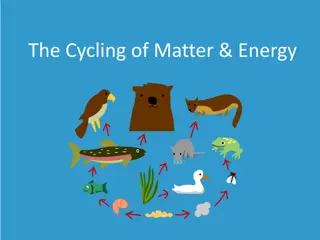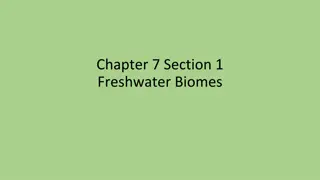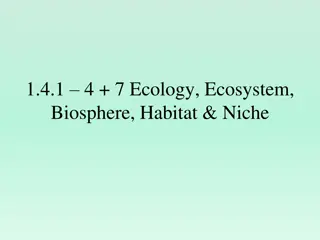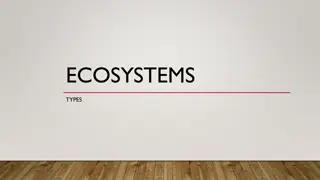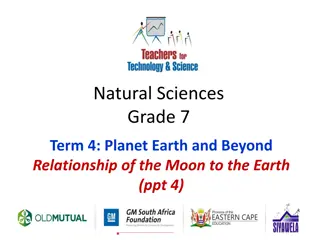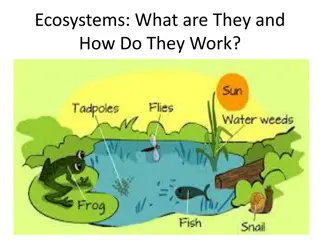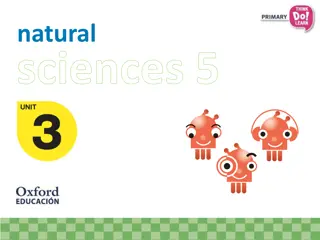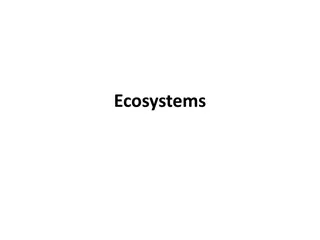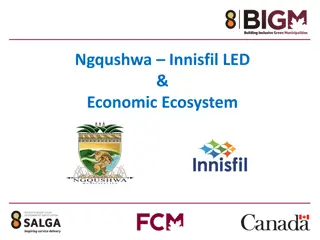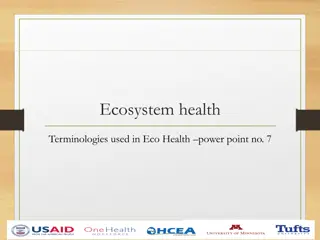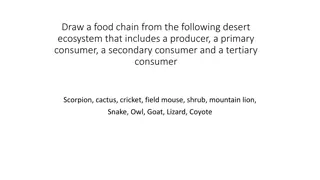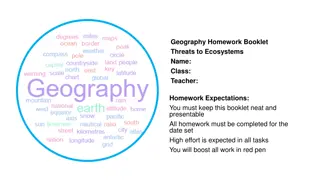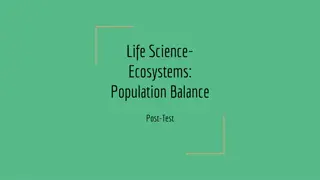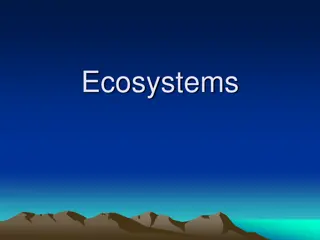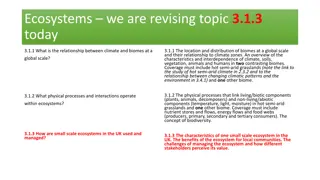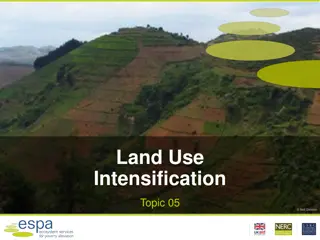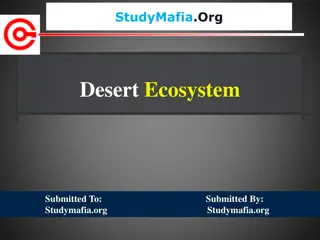Understanding Ecosystems: Types, Components, and Interactions
Different types of ecosystems, their components, and how they interact with each other. Explore natural ecosystems, such as deserts and rainforests, as well as artificial ecosystems. Discover the importance of terrestrial, aquatic, forest, marine, freshwater, tundra, and grassland ecosystems.
3 views • 6 slides
Understanding Typosquatting in Language-Based Package Ecosystems
Typosquatting in language-based package ecosystems refers to the malicious practice of registering domain names that are similar to popular packages or libraries with the intention of tricking developers into downloading malware or compromised software. This threat vector is a serious issue as it ca
0 views • 23 slides
Understanding Fish Ecology: Interactions, Diversity, and Environmental Factors
Fish ecology involves studying the distribution, interactions, and abundance of fish species in different ecosystems. This lab delves into the divisions of ecology, fish species diversity in marine and freshwater ecosystems, and the environmental factors affecting fish diversity and abundance. Disco
1 views • 7 slides
Interactions Among Species in Ecosystems
Understanding species interactions in ecosystems is vital for ecological balance. It involves concepts such as carrying capacity, niche occupancy, and symbiosis. Factors affecting a population's carrying capacity include resource availability, competition, predation, parasitism, and mutualism. Diffe
0 views • 21 slides
Understanding the Cycling of Matter and Energy in Ecosystems
Explore the interconnected web of life within biomes and ecosystems, where organisms play vital roles in maintaining balance. Learn about producers, consumers, and decomposers, and how energy flows through different trophic levels. Dive into the world of primary, secondary, and tertiary consumers, a
0 views • 24 slides
Exploring the Major Types of Ecosystems
Explore the diverse world of ecosystems, including grassland, aquatic, forest, and desert ecosystems. Learn about the biotic and abiotic factors that shape these environments and the critical roles they play in supporting life. Delve into forest ecosystems with their canopy, floor, and soil features
0 views • 29 slides
Exploring Freshwater Ecosystems: Lakes, Ponds, and More
Freshwater ecosystems offer a diverse range of habitats, from lakes and ponds to wetlands and rivers. These ecosystems host a variety of organisms adapted to different zones based on factors like sunlight and nutrients. Plankton, nekton, and benthos are key aquatic groups, with unique roles in the e
0 views • 24 slides
Importance of Biodiversity and Sustainability in Ecosystems
Biodiversity, the richness of life in genes, species, and ecosystems, plays a crucial role in sustaining the health of our planet and its inhabitants. It provides essential resources such as food, medicine, and economic benefits. Sustainability, the ability of ecosystems to maintain their structure
1 views • 6 slides
Understanding Ecosystems and Disease Ecology
Explore the diverse types of ecosystems, including autochthonous, anthropurgic, and synanthropic ecosystems, and their impact on disease ecology. Learn about biotopes, biocenosis, ecological mosaics, and ecological interfaces, and discover how infectious diseases can be transmitted across these inte
0 views • 10 slides
Impacts of Climate Change on Oceans and Marine Resources in the United States
The Fourth National Climate Assessment highlights the disruption of ocean ecosystems due to increasing global temperatures, leading to loss of habitats, changes in species composition, and food web structure. Marine fisheries face high risks from climate-driven changes, impacting distribution, timin
1 views • 10 slides
Understanding Ecology and Ecosystems
Discover the definitions and concepts of ecology, ecosystems, biosphere, habitats, and niches. Learn how living organisms interact with each other and their environment, explore different types of ecosystems, and understand the global ecosystem known as the biosphere.
0 views • 20 slides
Exploring Different Types of Ecosystems and Their Characteristics
Ecosystems are diverse environments encompassing both living organisms and non-living factors. From forest and grassland ecosystems to deserts and tundras, each type has unique features and interactions. Forests house a variety of organisms, while grasslands are dominated by grass and herbs. Deserts
0 views • 10 slides
Understanding Ecosystems: Structure, Components, and Functions
Ecosystems are intricate units where living organisms interact with each other and the environment. They consist of biotic (living) and abiotic (non-living) components, interrelated in a chain of interactions. Biotic components include autotrophs, heterotrophs, and decomposers, while abiotic compone
0 views • 15 slides
Exploring Shoreline Ecosystems in Grade 7 Natural Sciences
Shoreline ecosystems play a vital role in supporting diverse marine life. Tides influence the habitat availability on shorelines, affecting organisms' survival strategies. From rocky shores to sandy beaches, various flora and fauna have adapted to these dynamic environments. Students in Grade 7 Natu
0 views • 9 slides
Understanding Energy Flow in Ecosystems
Energy flow in ecosystems is vital for sustaining life as it moves through different trophic levels. Primary producers harness solar energy to create organic material, which is then consumed by herbivores, carnivores, and decomposers, forming intricate food chains. Terms like biomass, productivity,
0 views • 8 slides
Understanding the Intricacies of Food Chains in Ecosystems
Food chains play a crucial role in the transfer of energy within ecosystems. They consist of various trophic levels where organisms either consume or are consumed by others. Different types of food chains like grazing, detritus, predator, and parasitic chains interact to maintain the balance of ener
0 views • 15 slides
Understanding Ecosystems: A Beginner's Guide to Ecology
Explore the fascinating world of ecosystems with Mrs. Hart in this informative biology lesson. Discover the components of ecosystems, from biotic to abiotic factors. Learn how energy flows through the ecosystem, with autotrophs producing energy and heterotrophs consuming it. Identify different types
0 views • 33 slides
Understanding Ecology: Ecosystems, Biodiversity, and Energy Flow
Explore the intricate world of ecology through topics such as ecosystems, biodiversity, energy flow, and nutrient cycling. Delve into the concept of niches, biodiversity levels, and the importance of energy flow and materials cycling in sustaining ecosystems. Learn about the nitrogen and carbon cycl
1 views • 18 slides
Understanding Ecosystems: Components and Interactions
Ecosystems are dynamic systems where abiotic and biotic components interact to sustain life. Ecology studies these interactions, including nutrient cycling and energy flow. The biosphere, comprising the atmosphere, hydrosphere, lithosphere, and living organisms, forms Earth's life-support system. Ec
0 views • 22 slides
Understanding Ecology: Interactions in Ecosystems
Explore the intricate web of interactions in ecosystems through the study of ecology. Learn how biotic and abiotic factors shape ecosystems, trace energy flow, and understand nutrient cycles. Discover the importance of biodiversity and the impact of human activities on the biosphere. Dive into topic
0 views • 51 slides
Coastal Ecosystems: Salt Marshes and Mangroves Overview
Explore the factors influencing coastal ecosystems like latitude, tidal cycles, wave energy, and geological characteristics. Dive into examples from the Pacific Northwest and southeastern U.S., focusing on salt marsh ecosystems. Learn about plant communities and zonation in salt marsh environments.
0 views • 22 slides
Understanding Ecosystems: An In-depth Exploration
Delve into the fascinating world of ecosystems through this comprehensive guide, covering the definition, components, relationships, classifications, and key learnings. Explore the intricate balance between living and non-living elements, trophic relationships, food chains, and diverse ecosystem typ
0 views • 11 slides
Understanding Ecosystems and Global Biomes: A Comprehensive Study
Explore the fascinating world of ecosystems, producers, consumers, and the vital role of decomposers within these intricate systems. Delve into the impact of environmental changes like deforestation on ecosystems. Discover the geographical features and significance of hot deserts, tropical forests,
0 views • 26 slides
Explore Diverse Ecosystems through Visuals
Dive into the world of ecosystems with stunning images showcasing biogeographical realms, regions, ecological succession, lichens, mosses, forest types like coniferous, evergreen, deciduous, and thorn forests, as well as mangroves. Discover grassland ecosystems, fauna, desert ecosystems, and various
0 views • 20 slides
Understanding Ecosystems: A Comprehensive Guide
An ecosystem comprises both living (biotic) and non-living (abiotic) factors interacting in a specific area, with populations, communities, and ecology playing essential roles. Abiotic factors like temperature, water, sunlight, and wind influence species distribution, while biomes categorize ecosyst
1 views • 23 slides
Understanding Ecosystems: Definition, Structure, and Function
Ecosystems consist of living and non-living parts forming stable systems. They involve energy flow, nutrient cycling, and interactions between organisms and their environment. Ecosystems vary in abiotic and biotic conditions, with producers, consumers, and decomposers playing key roles. Changes in t
0 views • 13 slides
Exploring Community Ecology: Interactions in Ecosystems
Community ecology, as presented by Mr. Nitin A. Ghorpade, delves into the dynamics of species interactions within ecosystems. It covers concepts like communities, individualistic vs. interactive hypotheses, interspecific interactions, predation, parasitism, plant defenses against herbivores, and mor
0 views • 23 slides
Enhancing Local Economic Ecosystems for Sustainable Growth
Strategically defining and categorizing key players in local economic ecosystems can lead to more informed decision-making by public services, optimizing resource utilization, and maximizing community assets for impactful results. Ecosystem champions should possess a diverse skill set, including kno
0 views • 7 slides
Understanding EcoHealth: Terminologies and Concepts
Ecosystem health and EcoHealth explore the interconnectedness of humans, animals, and ecosystems. Concepts like One Health emphasize collaboration for optimal health across species. Terms like abiotic, biotic, habitat, and biodiversity are key in understanding ecosystems and their health. Symbiosis
0 views • 8 slides
Examples of Food Chains and Webs in Different Ecosystems
In the provided content, food chains and webs are illustrated in various ecosystems including desert, lake, and jungle. Each ecosystem depicts the interdependent relationships between producers, primary consumers, secondary consumers, and tertiary consumers, showcasing the flow of energy throughout
0 views • 38 slides
Geography Homework: Threats to Ecosystems Recap
Explore the weekly homework tasks focused on ecosystems, covering topics such as ecosystem functions, food chains, adaptations, and deforestation. From studying climate graphs to identifying key terms and definitions, this booklet aims to enhance understanding of environmental challenges. Dive into
0 views • 13 slides
Understanding Global Ecosystems and Climate Influences
Global ecosystems are defined by dominant vegetation types and are influenced by factors like climate, atmospheric circulation, altitude, relief, and ocean currents. The distribution and characteristics of ecosystems are shaped by global atmospheric circulation patterns, creating distinct belts of v
0 views • 18 slides
Ecosystems: Population Balance Post-Test
This post-test explores concepts related to ecosystems, population balance, and biodiversity. Questions cover topics such as energy flow in food chains, importance of biodiversity in sustainable ecosystems, ecological events in undisturbed gardens, impact of introduced species on native populations,
0 views • 6 slides
Understanding Ecosystems: The Interplay of Living and Nonliving Elements
Ecology is the study of relationships within ecosystems, where living organisms interact with each other and their environment. Ecosystems range in size from the vast Sahara Desert to small puddles, influenced by abiotic factors like water, temperature, sunlight, and more. Maintaining balance is cru
0 views • 13 slides
Understanding Carbon Storage in Biomes and Ecosystems
Explore the intricate carbon cycle within terrestrial ecosystems, focusing on carbon storage in biomass, litter, and soil. Delve into the differences in plant characteristics among various biomes and their impact on carbon sequestration. Gain insights into the distribution of tropical rainforests an
0 views • 13 slides
Insights on Ecosystems of Innovation and Government Role
Delve into the dynamics of innovation ecosystems and the vital role of government in fostering innovation. Topics include bridging gaps, open innovation, the demand side of innovation ecosystems, Candy Innovation Model, and key conclusions drawn. Explore how technology and market value are added, st
0 views • 45 slides
Understanding Ecosystems: Climate, Biomes, and Management
Explore the relationship between climate and biomes on a global scale, focusing on hot semi-arid grasslands and one other biome. Learn about the physical processes linking living and non-living components in ecosystems, such as nutrient cycles and food webs. Discover how small-scale ecosystems in th
0 views • 4 slides
Understanding Land Use Intensification and Its Impacts
Land use intensification is driven by increasing demands on ecosystems due to factors like population growth and changing dietary preferences. This process involves enhancing productivity through activities like land use conversion, increased inputs, and crop changes. Factors promoting intensificati
0 views • 23 slides
Impact of Hoover Dam on Ecosystems and Hydroelectricity
The Hoover Dam, built in 1935 on the Colorado River during the Great Depression, plays a significant role in controlling floods, providing power to millions, and impacting ecosystems and water supplies. The dam's construction altered the natural flow of water, changed the local climate, and created
0 views • 9 slides
Understanding the Characteristics of Desert Ecosystems
An ecosystem is a community of living and non-living organisms interacting in a specific area. Desert ecosystems are characterized by aridity, low rainfall, extreme temperatures, and high wind velocity. This overview discusses the defining features of desert ecosystems, emphasizing their unique envi
0 views • 23 slides




